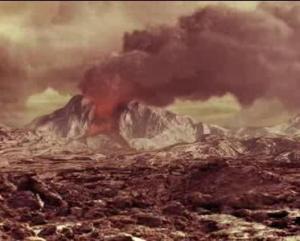Venus Express has provided the first map of the infrared wavelength of the Southern Venusian hemisphere. This new map reveals that our neighbor's planet may have been quite similar to Earth with both tectonic and ocean tectonic activities.
This map is a collection of more than 1000 photographs, taken from May 2006 to December 2007. Since Venus is covered by clouds, conventional cameras cannot observe its surface. . However, Venus Express explorer ship uses infrared wavelengths that can penetrate clouds.
Although radar systems have been used in the past to provide high-resolution Venus surface maps, Venus Express is the first spacecraft to produce a map showing chemical composition. of stone on Venus. This new data fits perfectly with scientists' doubts that the highlands on Venus are the ancient continents, surrounded by the sea and created volcanic activities.
Nils Muller of the Planetary Physics Research Group at Münster and DLR Berlin University said: 'This is not evidence, but it does show consistency. We can only confirm now that the plateau rock on Venus is not like anywhere else. '
Stones on Venus are different in shape because of the amount of infrared light they radiate into space, similar to the fact that a brick wall is heated by the sun during the day, and radiates heat at night. In addition, different surfaces radiate different amounts of heat due to the characteristics of the material called emission, which varies depending on the type of material. The infrared and visible thermal imaging spectrometer (VIRTIS) captures infrared heat when the explorer ship is flying around the planet's southern hemisphere,
 Volcanic activity on Venus? (Photo: European Space Agency)
Volcanic activity on Venus? (Photo: European Space Agency)
Eight Russian machines landed on Venus in the 1970s and 1980s, far from the highlands and found only basalt-like rocks at their landing point. The new map shows that the rocks on Phoebe and Alpha Regio plateaus are lighter in color and look 'older' than the rest of the planet. On Earth, the stone is so light in color that it is usually granite.
Granite was created when ancient rocks, formed from basalt, were pushed deep into the planet's interior by moving continents, a process known as stratigraphic tectonics. Water combines with basalt to form granite, and this mixture is 'regenerated' through volcanic eruptions.
Muller said: 'If there is granite on Venus, there must be an ocean and tectonic activity in the past'.
Muller points out that the only way to know for sure if the plateaus are continents is to take a landing ship there. Over time, Venus's water has disappeared into the universe, but there may still be volcanic activity. Infrared observations are very sensitive to temperature. However, in all the images, the temperature change was only in the range of 3-20 degrees Celsius instead of the temperature difference commonly seen in lava flows.
Although Venus Express does not see any evidence of volcanic activity taking place on Venus, Muller does not rule out this possibility. He said: ' Venus is a large planet, heated by radioactive elements in its lap. The planet may also have Earth-like volcanic activity. ' Scientists have observed that some areas appear to contain more nitrogenous rocks, which may well be a sign of a fairly recent volcanic flow.
The new map gives astronomers another tool in the quest for why Venus is similar in size to the Earth but evolved completely differently.
 Van Allen's belt and evidence that the Apollo 11 mission to the Moon was myth
Van Allen's belt and evidence that the Apollo 11 mission to the Moon was myth The levels of civilization in the universe (Kardashev scale)
The levels of civilization in the universe (Kardashev scale) Today Mars, the sun and the Earth are aligned
Today Mars, the sun and the Earth are aligned The Amazon owner announced a secret plan to build a space base for thousands of people
The Amazon owner announced a secret plan to build a space base for thousands of people